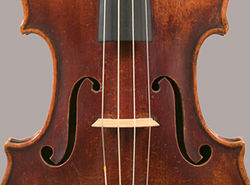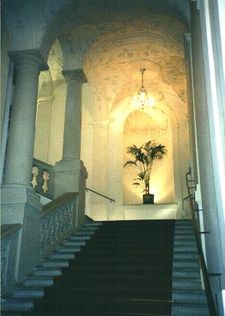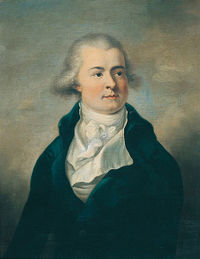Beethoven String Quartets
Beethoven's string quartets have been perennially popular from his time to our own. They anchor the entire string quartet repertory and represent one of the pinnacles of all chamber music of the time. With respect to their place in Beethoven's life, they span the whole of the composer's working period but pop up at irregular intervals, causing us to wonder whether Beethoven had to be in a particular frame of mind, or perhaps to have a new idea about how to go about their composition, or a compelling commission before digging in.
Like the rest of Beethoven oeuvre, the string quartets fall into three main groups, each of which has its own personality. The early quartets (Op. 18) give distinct evidence of the composer's promise and originality. The "Rasoumovsky" quartets Op. 59 come from one of Beethoven's most fertile and productive periods. Each is a classic in its own right. Collectively they show enormous strides in Beethoven's development and imagination. Opp. 74 and 95 continue in the same directions but with significant differences of character. The remaining quartets, from Beethoven's late period, are rugged, highly individual works that inadvertently document the composer's struggle with progressive hearing loss.

Performers and Listeners of Beethoven's time
Over the whole of the eighteenth century the growth of participation of amateurs in music-making was a major force in the rise of classical music. Large churches and courts had their own musical establishments. The ability to make music at home was a sign of social status, but it is also clear from countless narratives that noblemen who played well derived a great deal of contentment from their achievement. This underlying groundswell played an important role in Beethoven's life, for without the driving force of amateur players in Vienna, Beethoven's chamber music would exist in much more limited quantity.
The foremost quartet in Vienna was the Schuppanzigh Quartet, formed in the early 1790s. It played in the home of Count Carl Lichnowsky (1761-1814). The count, who had been a pupil and friend of Mozart, hosted the quartet every Friday morning. In addition to the count (first violinist), the quartet included Louis Sina, Franz Weiss, and Anton Kraft. Each of them in turn came from families including other musicians and had connections to other noble houses in Vienna. They attracted the interest of teachers, particularly since Ignaz Schuppanzigh (1776-1830), who was Beethoven's teacher in Vienna, trained so many other musicians of the time. He was held in highest esteem both as a violinist and as a conductor. He served as the concert master of Count Razumovsky. Schuppanzigh was also the dedicate of many works by other composers, among them of Franz Schubert's 'Rosamunde' Quartet.
Over the course of his life, especially after 1815, Beethoven's quartets passed beyond the realm of capability of assiduous amateurs. This change too had parallels in the broader musical scene, as concert halls grew in popularity and attracted the interest of a more bourgeois audience. However, Schauppanzigh remained a faithful supporter to the end. The late quartets, which were difficult to play and equally difficult to comprehend on one hearing, are particularly indebted to this fidelity.
The Early Quartets: Op. 18 (Quartets Nos. 1-6)
The range of techniques used by Beethoven throughout his quartets is stunningly broad. Each work has its own intricacies. Many have intertextual relationships with other works by Beethoven and by other composers. This set of quartets offers strong evidence of Beethoven's close study of the string quartets of Haydn (1732-1809) and Mozart (1756-1791), particularly Haydn's "Russian" quartets Op. 33 (1781) and Mozart's "Haydn" quartets (K. 387, K. 421, K. 428, K. 458, K. 464, K. 465; 1782-85).
Beethoven's first published collection of string quartets (Op. 18, published in Vienna in 1801) consisted of six works he composed between 1798 and 1800. By the reckoning of some these consisted the major achievement of his early years in Vienna. He closed in the quartet medium through explorations of other string combinations including a string trio (Op. 3, Eb Major, composed before 1794), a string quintet (Op. 4, also Eb Major, 1795), a set of three trios (Op. 9, 1797-98) and a handful of other chamber works, all composed since 1790. Opp. 3 and 4 were the earliest to be published (Vienna, 1796); the trios Op. 9 followed (1798).

Franz Joseph Maximilian von Lobkowitz
A significant portion of the moral support that allowed Beethoven to focus on this cogent, wide-ranging collection of quartets was provided by a nobleman of Beethoven's generation--the Bohemian prince Franz Joseph Maximilian von Lobkovitz (1772-1816). The prince spent most of the year in a new, magnificent palace in Vienna; important components of the family legacy (including music manuscripts and family portraits) are preserved in an near Prague. Although he was a general in the imperial army, the prince had a highly cultivated love of music and played several instruments. Without his indulgence, we would lack seven of Beethoven's string quartets, three symphonies (the third, the fifth, and the sixth), and the triple concerto.
Lobkowitz was an ardent fan of the music of his time. He was particularly fond of the music of Handel and Haydn. He studied the violin and cello. He was a member of Vienna's Gesellschaft der Musikfreunde. He met Beethoven in 1795 and two years later, upon turning 25, he established a Kapelle of five musicians in the family's Viennese palace. Its concerts between 1798 and 1806 featured string and piano quartets, arias from recent operas, and other chamber works.
In 1807 Lobkowitz assumed the direction of productions at the Hoftheater (the court theater). Johann Friedrich Reichhart wrote of the count in 1808/09 that "he lived for music day and night." Under his direction the quantities of musicians he employed rose steadily. At one point they totalled 43 instrumentalists and 36 singers. The payroll became unmanageable. To underwrite his costs Lokowitz recruited a number of noblemen to the cause of his musical enterprises. Among them were Count Kinsky and Archduke Rudolf, the emperor's son. By 1814, however, Lobkowitz himself was almost bankrupt. He fled the city. The Kapelle was dissolved in 1814, but the Lobkowitz Palace was remembered as the home of an "Academy of Music." The count died in 1816.
The Middle-Period Quartets
Op. 59 (Quartets Nos. 7-9)
The three quartets of Op. 59 (popularly known as the "Rasumovsky" Quartets) are among the best loved of Beethoven's chamber works. They were composed in 1806, a pivotal year in the fortunes of Vienna.
Andrey Kirillowitz Rasumovsky (1752-1836), the quartets' patron, was born in St. Petersburg. His diplomatic career began at the age of 24. When he arrived in Vienna as Russian ambassador (1792-99; 1801-06) he had already served posts in Italy, Denmark, and Sweden. Like Count Lobkowitz he had a solid musical education and played the violin well. The sister of Rasumovky's wife Elisabeth was married to Count Lichnowsky, another of the great lovers of chamber music in Vienna.
Razumovsky's relationship with Beethoven and the quartets Op. 59 began in 1804. The works themselves were published in 1808, the year in which Razumovky asked Schuppanzigh to establish "the best quartet in Europe" in his palace. Performances there appear to be have entirely private.
In 1814 Rasumovsky (retired as ambassador but now serving as special Russian representative) undertook an unprecedented reconstruction of his palace in order to accommodate up to 700 guests for the Congress of Vienna (1814-15) and the arrival of the Czar Alexander I. A fire in the expanded palace on the last day of 1814 soured Razumovsky on Vienna. The quartet was dismmissed. Razumovsky returned to Russia, where he became an ardent promoter of Beethoven's music. Schuppanzigh followed.

Op. 74 (Quartet No. 10)
Beethoven's "Harp" quartet, composed in 1809 and published a year later in Leipzig and London, was dedicated to Count Lobkowitz. The nickname comes from passages in the first movement requiring pizzicato playing by rotating pairs of instruments. These markedly contrast with a lyrical melody. Beethoven's work on the quartet occurred shortly after he had composed most of the Fifth Symphony.

Lewis Lockwood calls attention to the concentration that the composer brought to bear in the year when Vienna was torn apart by strife. As Napoleon's army captured the city the royal family sought safety in Hungary. Beethoven made the best of situation by agreeing to join Jérôme Bonaparte's service in Kassel. This tactic led to a complicated arrangement whereby the archduke (Rudolf), Count Lobkowitz, and Prince Kinksky would jointly guarantee a generous annual salary for Beethoven to remain in Beethoven. It was the serenity this new financial brought him that enabled him to work with so much focus during 1809 and for several years thereafter. Op. 74 is exceedingly rich in musical ideas, idioms, and playing techniques used to enhance the work's architecture. The autograph survives in Krakow.
Op. 95 (Quartet No. 11)
Sometimes nicknamed the "Serioso," this quartet was nominally composed late in 1810 but may not have achieved its final form until a year or two later. Schuppanzigh took part in the premier in 1814. Publication did not occur until 1816. Seow-Chin Ong views it as a close relative of the Egmont overture, Op. 84 (also 1810), partly because the two works share the key of F Minor and project similarly funereal moods. The overture and other incidental music for Göthe's drama (1775-88) were prepared for performance at Vienna's Burg-Theater. Structural details of both works also contribute to the possibility of a close relationship between the two works. Beethoven's contribution was solicited in the autumn of 1809.
The Late Quartets
Op. 127 (Quartet No. 12)
The commission for Op.. 129, 132, and 130 offered by Prince Nicolai Golitsin owed to the intervention of Schuppanzigh, who had moved to St. Petersburg in 1816 but had returned to Vienna (where he became leader of the court opera) in 1823. There he was given permission by Beethoven to give the premier of the new quartet, which Beethoven completed in 1825.
Owing to the quartet's poor reception of the premier, Beethoven reinstated the violinist Josef Boehm (who had served in Schuppanzigh's absence) as concert-master and personally supervised rehearsals for future performances. There can be little doubt that the first audience would have found the work perplexing, for its construction was radically different from that of earlier quartets. In place of predictable harmonic schemes and the elegaic melodies that had characterized Beethoven's Middle Period, Op. 129 adopted a harmonic plan based on tonally distant (sometimes enharmonic) key relationships.
Op. 132 (Quartet No. 13)
Schuppanzigh was back in Beethoven's good graces by the time this quartet had its premier, on November 6, 1825. Schuppanzigh was also responsible for the premiers of Opp. 130 and 135 (the latter premiered after Beethoven's death). Op. 132 consists of five nominal movements. Of these the third is a highly complex sequence of eight sections, some with German qualifiers appended to the traditional Italian tempo indications. Some examples are the "Heiliger Dankgesang eines Genesenen an die Gottheit, in der lydischen Tonart" [a holy thanksgiving hymn by one nurturing his divinity, in the Lydian mode]. The concluding section of the third movement is characterized as "Molto adagio. Mit innigster Empfindung" [Very slow. With intimate feeling].
Opp. 130 and 133 (Quartet No. 14, Versions A and B]
Beethoven had intended that Op. 127 should have six movements rather than four, but the plan to add movements after the first and (old) third movement never materialized. Op. 130, composed shortly after Op. 127, did alter the hallowed movement structure of the string quartet but in an entirely different way from the abandoned idea for Op. 127. After three very busy movements in a more or less conventional mold (Adagio-Allegro; Presto; Andante...poco Scherzoso) the composer introduced three more arbitrary ones--a dance "in the German style; an aira-like cavatina; and the concluding Grosse Fuge, Op. 133. This last "movement" (written late in 1826) was a work in its own right, consisting of an overture and seven movements. Neither the listening public nor the publisher was easily able to conceive of Op. 133 as an integral part of of Op. 130, which, however, was incomplete without a "final" movement of some kind.
Op. 131 (Quartet No. 15)
The C# Minor quartet, completed in 1826, consisted of what were nominally seven movements. Of these the fourth was extremely elaborate. Dedicated to Baron Josef von Stutterheim, it is said to have been Beethoven's personal favorite. The quartet shares motivic material with Opp. 132 and 130, leading some performers to group the works as a triptych. The work shares with the other late quartets a challenging harmonic landscape. Its final cadence it to C# Major. For many listeners it seems to share an esthetic space with Beethoven's Missa Solemnis.
Op. 135 (Quartet No. 16)
Like the first quartet of Op. 18, the last string quartet Beethoven composed (late in 1826) was in F Major). It is last blatant in its pursuit of extremes than the other late quartets but expresses the composer's torment no less capably than the others. Its final (fourth) movement explores, with bilingual labels, a "difficult decision" (Der schwer gefaßte Entschluß} in a rhetorical (grave-allegro-grave-allegro) manner.
Scores (downloadable)
Beethoven was a strong believer in preserving authoritative editions of his music. The original Breitkopf & Härtel edition of his works was published in 1862-65. It was one of several collected editions the firm published in that period for composers who, having died over the preceding century, still had a robust following in Germany. Since research into Beethoven's life and music continues vigorously to the present day, it is inevitable that reasons for publishing new editions accrue over time. The Beethoven-Archiv in Bonn, the city of Beethoven's birth, has been preparing a new critical edition (by G. Henle Verlag) of the composer's works to reflect and absorb all that has been learned over recent decades. It was begun in 1961.
| Opus | Title | Key | Nickname | Date | CCARH score/parts (PDF) | MuseData digital scores |
|---|---|---|---|---|---|---|
| Op. 18/1 | String Quartet No. 1 | F Major | 1798-1800 | full | 01 02 03 04 | |
| Op. 18/2 | String Quartet No. 2 | G Major | 1798–1800 | full | 01 02 03 04 | |
| Op. 18/3 | String Quartet No. 3 | D Major | 1798–1800 | full | 01 02 03 04 | |
| Op. 18/4 | String Quartet No. 4 | C Minor | 1798–1800 | full | 01 02 03 04 | |
| Op. 18/5 | String Quartet No. 5 | A Major | 1798–1800 | full | 01 02 03 04 | |
| Op. 18/6 | String Quartet No. 6 | B♭ Major | 1798–1800 | full | 01 02 03 04 05 | |
| Op. 59/1 | String Quartet No. 7 | F Major | "Razumovsky" | 1805–6 | full | 01 02 03 04 |
| Op. 59/2 | String Quartet No. 8 | E Minor | "Razumovsky" | 1805–6 | full | 01 02 03 04 |
| Op. 59/3 | String Quartet No. 9 | C Major | "Razumovsky" | 1805–6 | full | 01 02 03 04 |
| Op. 74 | String Quartet No. 10 | E♭ Major | "The Harp" | 1809 | 01 02 03 04 | |
| Op. 95 | String Quartet No. 11 | F Minor | 1816 | 01 02 03 04 | ||
| Op. 127 | String Quartet No. 12 | E♭ Major | 1825 | 01 02 03 04 | ||
| Op. 130 | String Quartet No. 13 | B♭ Major | 1825–27 | full | 01 02 03 04 05 06 | |
| Op. 131 | String Quartet No. 14 | C♯ Minor | 1825–27 | 01 02 03 04 05 06 07 | ||
| Op. 132 | String Quartet No. 15 | A Minor | 1825 | 01 02 03 04 05 | ||
| Op. 133 | Grosse Fuge [No. 13b] | B♭ Major | 1825–27 | 01 | ||
| Op. 135 | String Quartet No. 16 | F Major | 1826–27 | 01 02 03 04a 04 |
Audio Examples
Audio examples from each movement of the three Op. 59 quartets are provided by the Digital Archive of the Beethoven-Haus in Bonn, the city of Beethoven's birth.[1]
Credits
This edition of the Beethoven String Quartets, which is based on the Breitkopf & Härtel edition of xx, has been prepared by Edmund Correia Jr. and Frances Bennion. This wiki site has been developed by Craig Stuart Sapp and Eleanor Selfridge-Field. Valuable insights and advice have been offered by several of our colleagues at Stanford University. Audio contributions by the St. Lawrence String Quartet and the New Esterhazy String Quartet are warmly acknowledged.
Published on December 31, 2012 by the Center for Computer Assisted Research in the Humanities at Stanford University.